A Guide to Feline Pregnancy
Posted: 10/21/2022 | BY: Jenna Bruce | Categories: Cat , Pet care , Top Tips
Sometimes life throws us surprises. And sometimes those surprises come in the form of an unexpected pregnancy, including a feline pregnancy!
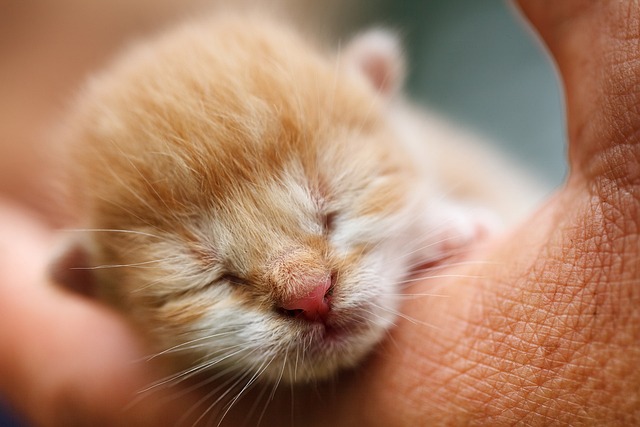
If your cat is pregnant, you’ll definitely want to read this entire article to learn the stages of a cat pregnancy, how to care for your cat during pregnancy, and how to prepare for the eventual birth.
Be a Responsible Cat Parent
We should mention that cat pregnancy happens easily and in the blink of an eye. This is why you tend to see such a large cat population in some cities and towns, and why pet stores and adoption centers are often overwhelmed.
Once a cat goes into heat for the first time, usually around the age of 4 months, she will regularly go into heat from Spring to Fall. Unless you plan on breeding your cat, it is highly recommended that you spay her as close to 4 months as possible. This will prevent a potential unplanned pregnancy. If you are considering breeding your cat, you will want to speak with your vet to ensure your cat is healthy and up to date on medical treatments.
How Long are Cats Pregnant?
Cat gestation is far shorter than humans and other mammals. Mother cats will be pregnant for roughly 60-67 days, so about two months. It’s important to understand this, especially if your cat has become unexpectedly pregnant. Once the pregnancy begins, you have a very short window of time to prepare for the tiny fur babies’ arrival.
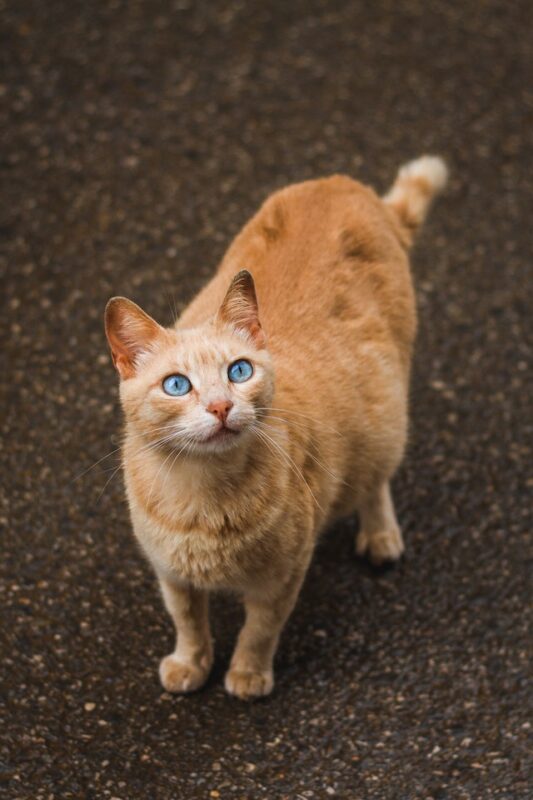
How to Tell if Your Cat is Pregnant
There are some key indicators that your cat may be pregnant. Signs of feline pregnancy include:
- Nipple enlargement (at around 2 weeks)
- “Morning sickness” – occasional sickness
- Weight gain
- Swelling abdomen
- Food aversions or changes in eating habits
- Nesting – preparing a space for birth
Has your cat recently been in heat? Is she showing any of the above signs? If so, there is a very good chance she may be pregnant. It is important to mention that some of these signs may not present themselves until right before it’s time to give birth. If you suspect your cat may be pregnant, make an appointment with your vet to ensure your expecting mother cat is healthy. Should your cat be far enough along, your vet will be able to confirm pregnancy through a physical exam. If your cat’s pregnancy is new, your vet can perform a blood test that will determine if your fur baby is pregnant.
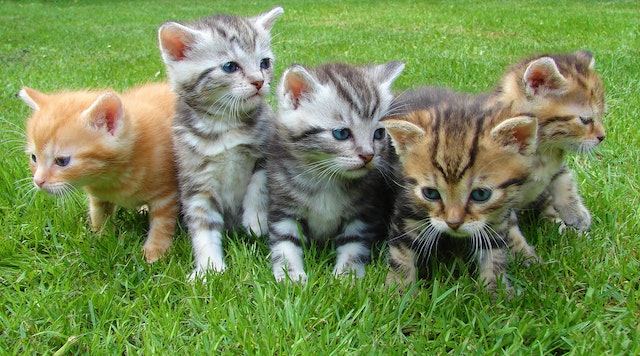
The Stages of Cat Pregnancy
There are three stages to a cat’s pregnancy:
Stage 1: Fertilization
A cat that has not been spayed will be in heat every 2-3 weeks from Spring to Fall. During this time she will be in ovulation, and her eggs will become ready to be fertilized. While in heat, you will most likely notice your cat shows more affection. She may purr more during this time and rub her head against yours more often. If fertilization occurs during this time, the fertilized eggs will implant to the uterus wall and begin to develop.
Stage 2: Embryo Development
At roughly the 3-week mark, the embryos will begin to grow and develop at a rapid rate. At this time, your cat will most likely begin to eat more and show weight gain, if she hasn’t already. Her nipples will also begin to swell and lengthen.
Stage 3: Fetus Development
During this final stage of pregnancy, the embryos have developed into fetuses. These fetuses will rapidly grow into kittens. You will notice your cat is more tired during stage 3 and will require more nutrition and extra TLC.
Pre-Labor And Labor
As the big day draws near, your cat will begin what is called the “nesting phase.” This is when she will look to find a comfortable spot to give birth, one where she feels safe. During this time, you may offer her a box or a laundry basket that you’ve lined with towels or blankets. Be sure you choose towels and blankets that you don’t mind getting ruined during the birthing process. Because they will be ruined.
Some cats will happily take to the box you offer, some won’t. Don’t be offended if your cat chooses a different spot. This time is all about her comfort.
You may also notice her behavior change. She may become more affectionate or may become more withdrawn. This change signals that labor is near. You may also notice she is beginning to show signs of milk production. Another indicator kittens are soon to follow.
Many cats will stop eating 24 hours before labor, which can last for up to 36 hours if she is a first-time mother. Once labor begins, you will need to strike a delicate balance between being near enough that you can watch for any complications, and also giving her enough space as mothers like privacy at this time. Once all of the kittens have been born, you can relocate them to a clean and comfortable spot, such as the box you made, if your mother didn’t give birth in it. If she did birth her babies in the box you made, have a second one handy to house the new arrivals. Be sure to have this box near your cat, who will be exhausted and need to rest.
Cat Labor Emergency Kit
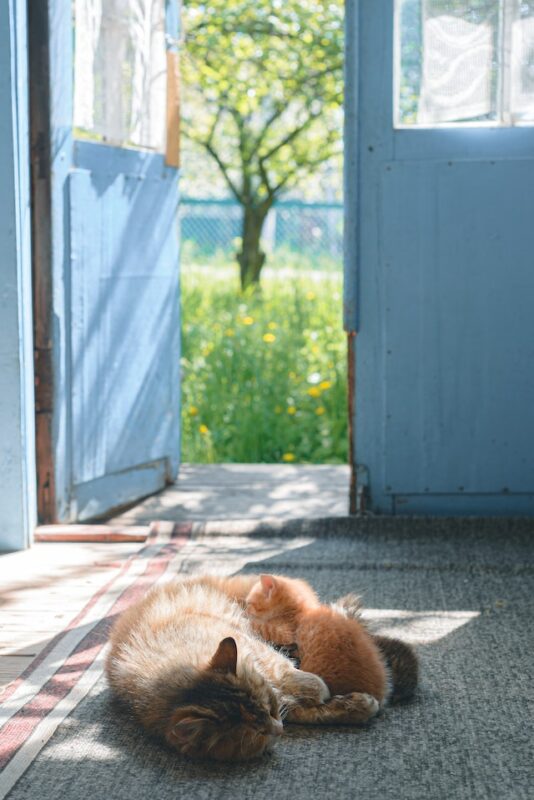
When all goes well with cat labor, you don’t need to do a thing but sit back and watch the wonders of nature unfold. But it’s always a good idea to have an emergency kit on hand, just in case mama cat has some trouble.
An important note: Never try and interfere with the birthing process unless you are absolutely certain there is a real problem. Giving birth is a natural experience and cats generally need no human intervention.
Having said that, in those rare instances when intervention is necessary, be sure your kit contains plenty of clean sheets and towels. Flannel is a great material because it will keep your new kittens warm and their claws won’t get tangled up in the material.
Your kit should also contain a sterilized pair of scissors and a suture kit should you have to cut any of the cords. Be sure to have some stock iodine to swab the kitten’s little belly buttons to prevent infection.
Your kit should also have some disposable gloves, sterilized gauze pads, and non-waxed dental floss. The floss will be used to tie off the cords if your mother cat does not do it on her own.
A Few More Items to Consider
Some cat parents also like to include a scale to weigh any kittens that seem to have been born very small. They will also have items on hand such as kitten milk replacement formula and feeding bottles in case any of the newborns have trouble nursing.
And finally, be sure to have your vet’s number on hand, as well as the number of an emergency vet clinic should the birth happen after hours. Call if you see any signs of trouble. The vet will be able to tell you what to do.
You’ll also want to call your vet if your cat’s pregnancy extends beyond 67 days, if she seems to be having uterine contractions for a long time but no kittens have been born, or if she is leaking any kind of discharge that has an “off” odor that suggests an infection.
Never be afraid to call your vet during this time. It is always better to be safe than sorry. You are your cat’s advocate so speak up and seek answers if you think something may be wrong.
Signs Your Cat is in Trouble
As we mentioned, when your cat is giving birth, your job is to sit back and monitor closely, but try not to get involved unless something appears to be very out of sorts.
The following are signs your cat is in trouble:
- Your cat is experiencing contractions but hasn’t given birth to a kitten in 20 minutes
- Part of a fetus or part of the placenta is protruding from your cat’s vulva but she’s unable to pass a kitten within 1 to 2 minutes
- Over two hours pass in between kittens
- After giving birth, the mother has a discharge from the vulva that’s foul-smelling
- After giving birth, the mother isn’t eating normally, is acting abnormally, has diarrhea, is vomiting, or has seizures or tremors
How to Care for Your Pregnant Cat
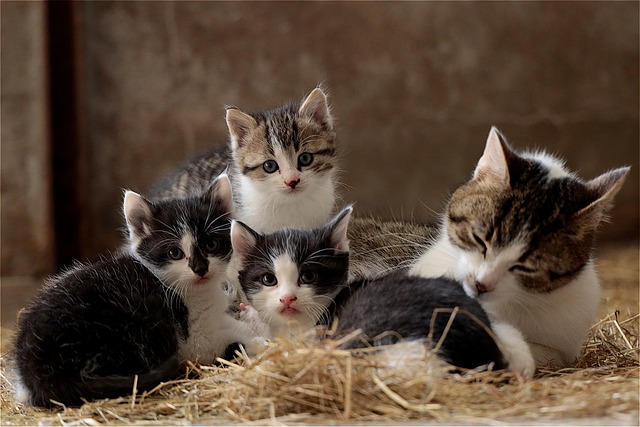
So now you know how long gestation is, you know the three main stages of pregnancy, and you have an idea of what the birth will actually be like and how you can prepare. Now it’s time to discuss how you can help your mama cat during her pregnancy to ensure she is as healthy as possible.
More Nutrition
Just like pregnant women, pregnant cats require extra nutrition because they are not only eating for themselves but for the growing kittens inside them. Most vets will recommend you feed your cat, regardless of her age, a kitten formula food. These foods offer more calories and nutrition than regular adult formula. Of course, speak to your vet for guidance on what and how much to feed your pregnant cat. Your cat will need an increased amount of food, particularly near the end of pregnancy.
Morning Sickness in Cats
Cats experience morning sickness just like human mothers. This usually occurs in cats in the 3rd or 4th week of pregnancy due to hormonal changes and the distension of her uterus. During this time your cat may become apathetic and choose not to eat because she is nauseous. This typically only lasts a few days, but it is important to closely monitor her. If she doesn’t eat or drink for more than two days, bring her to the vet to be checked.
X-Rays
At around the 55-day mark, it’s a good idea to bring your mama cat in to get an X-ray. This way you can know exactly how many kittens are developing. If you know how many fetuses your cat is carrying, you’ll be able to tell when she is finished giving birth or if she is in some kind of distress in between kitten births.
Work Closely with Your Vet
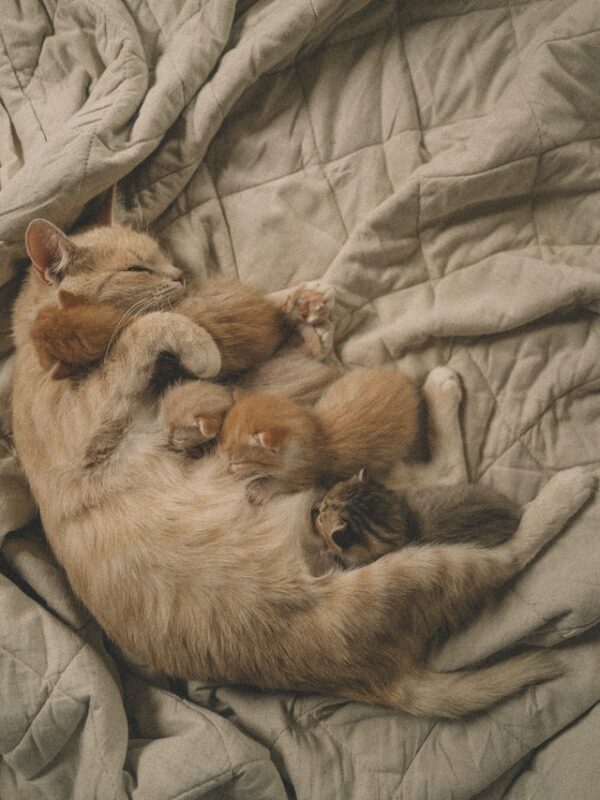
Watching your cat become a mother is an amazing thing to experience. But it is also a big responsibility to care for a pregnant cat. It is a good idea to stay in touch with your vet at every stage of the pregnancy to ensure everything is going well and mama and kittens are healthy.
Once the kittens have been born and are 6 weeks of age, you’ll want to bring mama and kittens in for a check-up. If you are not a purebred cat breeder, speak with your vet about having your cat spayed as soon as possible. This procedure can usually happen after the kittens are weaned.
There are So Many Cats That Need Homes Already
It’s very important to mention that we already have an overpopulation of cats in shelters and on the streets in this country and all over the world. We should all be responsible cat parents and see to it that our fur babies are spayed and neutered as early as possible. Only experienced and responsible breeders who know what they are doing should have cats that give birth.
Help Your Cat with a Pet Insurance Plan
Caring for your fur baby, and your fur baby’s babies is a big responsibility. You want to be sure you get them all the care they need so they can be healthy and happy. But are you financially prepared if your cat or one of her kittens experiences an unexpected accident or life-threatening illness?
A pet insurance plan helps you get the care your fur babies need while at the same time protecting your savings account. Did you know some plans can reimburse for up to 90% of the vet bill?
References:
- Spaying And Neutering. Cornell University College Of Veterinary Medicine, 2020
- Management Of Reproduction Of Cats. Veterinary Manual
- Scherk, Margie A et al. 2013 AAFP Feline Vaccination Advisory Panel Report. Journal Of Feline Medicine And Surgery, vol 15, no. 9, 2013, pp. 785-808. SAGE Publications, doi:10.1177/1098612×13500429
Disclaimer
The information contained on this blog is intended for informational and educational purposes only and should not be construed as medical advice. It is not a substitute for professional veterinary care. Always consult with your veterinarian before making any changes to your pet's health care or treatment plan.
The authors of this blog are not veterinarians and do not claim to be experts in pet health. The information provided here is based on our own experiences and research, as well as information from reputable sources. However, we cannot guarantee the accuracy or completeness of this information.
We encourage you to do your own research and consult with your veterinarian before making any decisions about your pet's health.
Previous post
How Do Dogs Choose Their Favorite Person?Next post
How Much Does Dog Teeth Cleaning Cost?Compare top pet insurance providers plans.
Enter your dog’s age in years and months to calculate their age equivalent to human years.
Calculate your dog’s ageEnter your cat’s age in years and months to calculate their age equivalent to human years.
Calculate your cat’s age